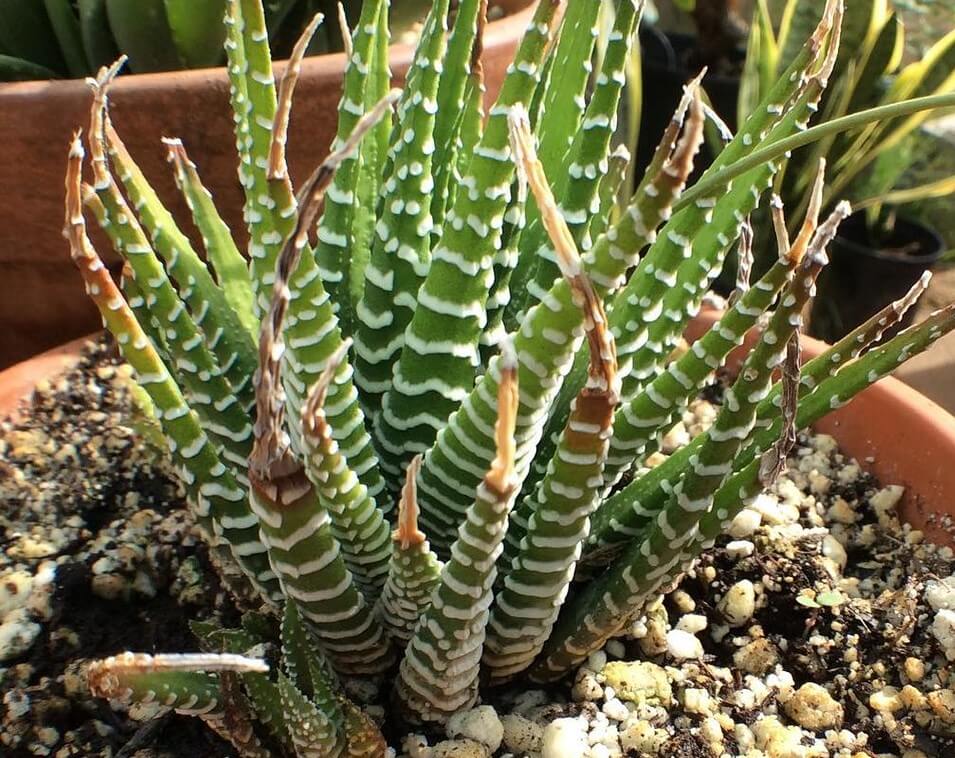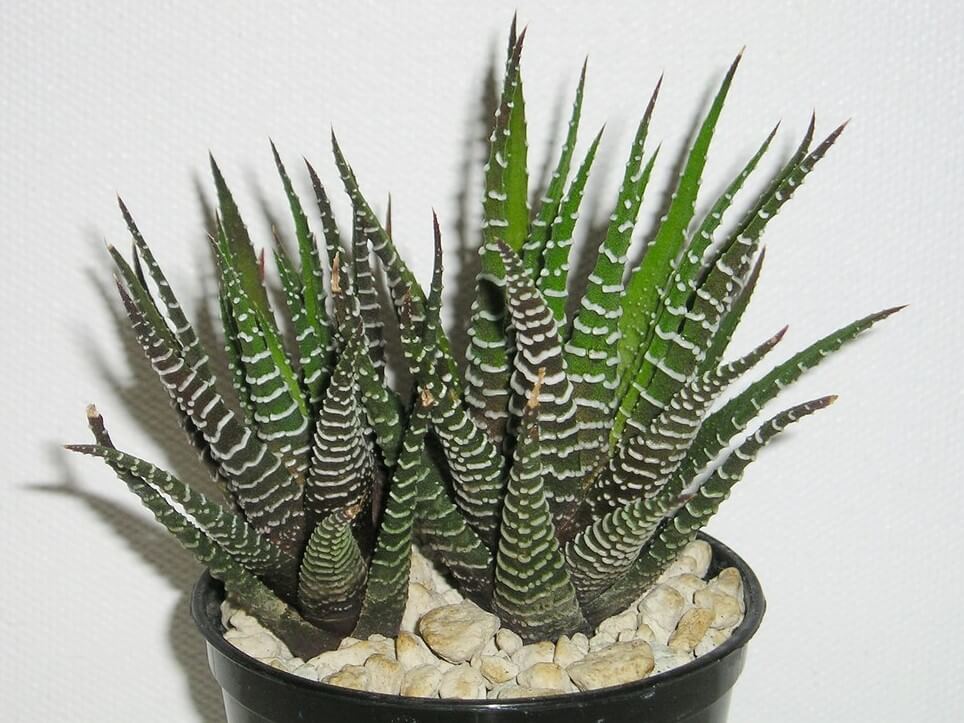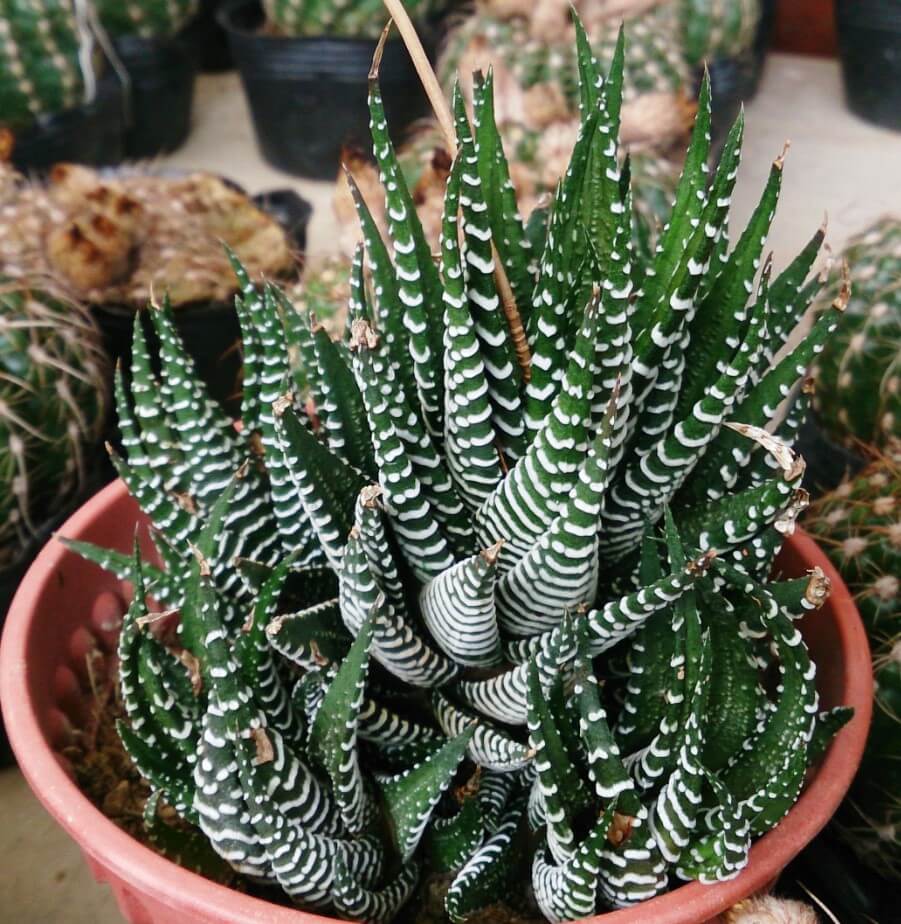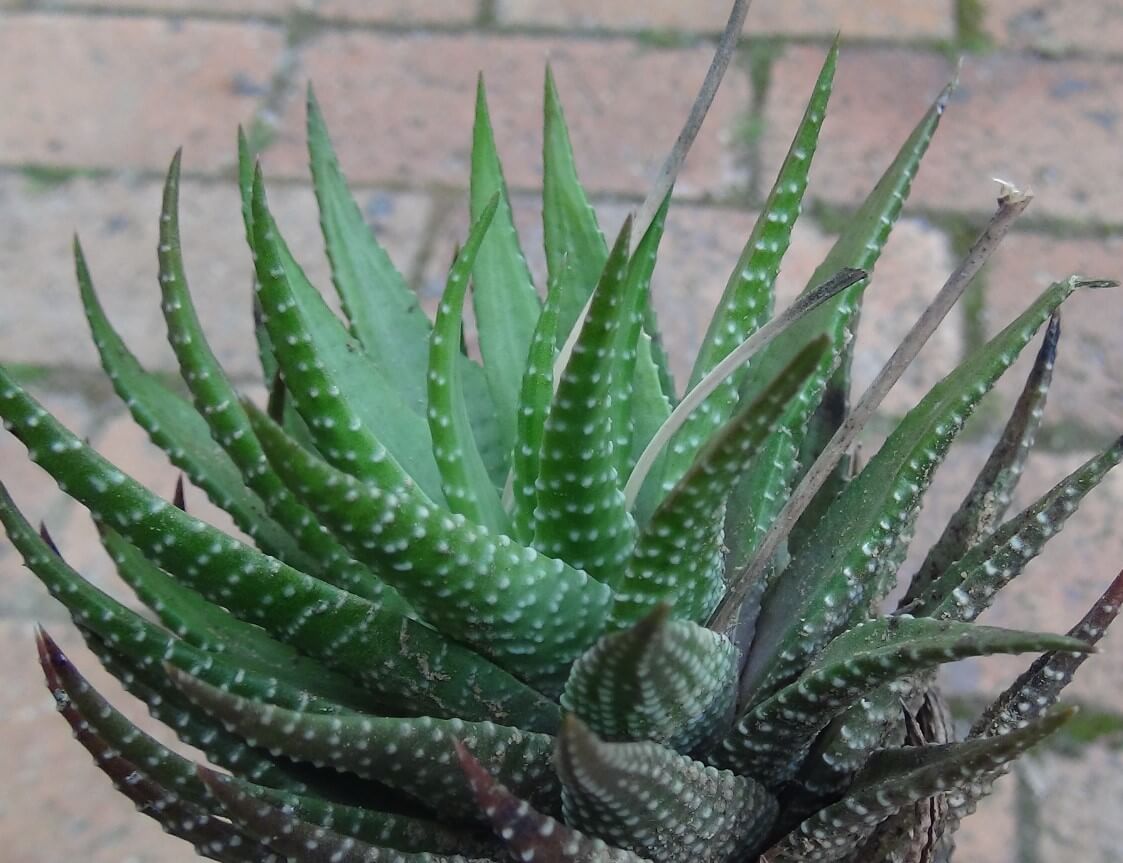The Haworthia Fasciata is a delightful little succulent hailed for its distinctive beauty. This plant is visually charming with its upright leaves decorated in zigzag bands.
People want it as a houseplant. The Haworthia Fasciata is not just a pretty face in the succulent world. It is an easy-going, low-maintenance companion for all gardeners, regardless of experience.
A Cactus Relative From Southern Africa
The Haworthia Fasciata is a succulent plant from South Africa. It belongs to the Xanthorrhoeaceae family.
The plant lives in the eastern cape region. It grows during winter when it rains. This helps it survive the hot, dry summers. The Haworthia Fasciata lives in shady cracks and crevices on rocky outcrops.
The zebra plant, also known as the affectionate name, grows well in bright, filtered light. Overhangs and larger plants protect it from extreme exposure. The soil should be well-drained.
Over time, several varieties of the popular Haworthia Fasciata have emerged through cultivation. The standard Haworthia Fasciata has dark green leaves with raised white bands. There are many types of leaves, each with different shapes, sizes, and colors. Some have red borders or white polka dots.
Some types produce solitary rosettes while others form clustering offsets. All types of Haworthia Fasciata have distinct stripes, whether alone or in a group. That’s why they’re called “zebra plants.””

Key Takeaways
| Key Takeaways from Caring for Haworthia Fasciata | |
|---|---|
| Petite South African Succulent: | Haworthia Fasciata is a petite succulent native to South Africa, valued for its decorative striped foliage arranged in rosettes. |
| Zebra-Like Bands: | Varieties may differ in leaf shapes and markings, but all share the signature zebra-like bands. |
| Light and Soil Requirements: | Haworthia thrives with bright, indirect light and well-draining cactus soil. Allow the soil to dry between waterings. |
| Temperature Considerations: | Ideal temperatures range from 65-80°F. Bring the plant indoors if temperatures will drop below freezing. |
| Propagation and Repotting: | Easily propagate new plants from offsets and leaves. Repot every 2-3 years as needed. |
| Troubleshooting and Prevention: | Troubleshoot issues like sunburn, pests, and overwatering. Proper care can prevent most problems. |
| Compact and Versatile: | The compact size makes it perfect for containers and dish gardens. It can be mixed with other small succulents. |
| Easygoing Nature and Visual Appeal: | Its easygoing nature and propagation potential add to its visual appeal as a low-maintenance houseplant. |
| Overall Recommendation: | Haworthia Fasciata is a gorgeous, low-maintenance succulent that makes a fantastic indoor companion. |
An Adaptable Size and Shape
One of the qualities that makes the Haworthia Fasciata so coveted is its petite size. Reaching 3-6 inches tall and wide, the Haworthia Fasciata stays compact as it matures. This makes it suited for cultivating indoors.
Gardeners can put Haworthia Fasciata plants in containers on windowsills and desks. This won’t take up much space. These succulents also thrive in terrariums and dish gardens alongside other small plants.
If given plenty of light, the Haworthia Fasciata grows in a pleasing, rounded shape. But, insufficient sunlight causes leggy, elongated growth that compromises its beauty. Fortunately, pruning back any stringy sections restores the plant’s form.
And like many succulents, the zebra plant propagates well from cuttings. Gardeners can make more Haworthia plants by cutting off the top and planting it in soil.

Low-Maintenance Care Regimen
To have successful houseplants, busy or forgetful gardeners should choose low-maintenance ones. Here again, the adaptable Haworthia Fasciata delivers.
To keep Haworthia healthy, water it sometimes and transplant it every year in well-drained soil for cacti. As long as it receives adequate sunlight, it thrives with minimal intervention. These plants can even tolerate a bit of benign neglect if you overlook watering them from time to time.
The Haworthia Fasciata needs good care and ideal conditions to thrive and grow well. But even with just the basics, its decorative nature and staying power make it a standout.
Are you a gardener? If so, consider the Haworthia Fasciata. It’s a small succulent that thrives with minimal care.

Exploring the Dazzling Diversity of Haworthia Fasciata Varieties
The Haworthia Fasciata is great, but there are more options for succulent enthusiasts. Growers have bred different Haworthia cultivars with unique details that stand out from the standard type.
The Classic Haworthia Fasciata
The Haworthia Fasciata has glossy green leaves with raised white bands, like zebra stripes. These distinctive markings gave rise to its common name, the zebra plant. The leaves emerge in a rosette pattern, stacking upright upon one another in a pleasing spiral. Mature rosettes reach about 4 inches tall by 3 inches wide. The wild type grows alone in a rosette shape, but cultivated varieties can spread out over time and form clumps. However, the rosettes easily separate for repotting or sharing.
Slender Leaves of Haworthia Attenuata
Haworthia Attenuata sets itself apart with elongated, pointed leaves that lack the raised white bands. Instead, rounded bumps containing translucent “windows” decorate the dark green leaves. Backlighting reveals the leaf windows as white dots, giving rise to another common name – the zebra cactus. However, it is not a true cactus. Attenuata grows in clusters more readily than the standard Fasciata.
Distinctive Curves of Haworthia Limifolia
Haworthia Limifolia takes on a dramatically different look with spiraled, curved leaves. The outsides of the leaves showcase white markings, while the insides display striking tubercles. Limifolia remains solitary or slowly forms small clumps. It also stays smaller than standard Haworthia Fasciata with rosettes under 3 inches wide.
Miniature Rosettes of Haworthia Retusa
Haworthia Retusa charms with tiny, stubby, triangular leaves adorned with raised white bands. Rarely exceeding 2 inches in diameter, Retusa forms petite rosettes perfect for dish gardens and fairy gardens. Offsets may appear over time, creating clumps. The small size and relatively slow growth make Retusa an ideal subject for bonsai enthusiasts as well.
Rounded Windowpanes of Haworthia Cooperi
The Haworthia Cooperi gets its name from its triangular leaves. The leaves have rounded windowpanes, not elongated tubercles. These translucent windows give the succulent a unique look. Offsets readily sprout from the base, forming clumps over time.
Haworthia Truncata’s Stacked Columns
Haworthia Truncata takes on the appearance of a miniature aloe. Its broad, triangular leaves lack bands and instead showcase textured ridges. The rosette pattern stacks the leaves in neat columns. Truncata remains solitary or slowly forms clumps.
Speckled Leaves of Haworthia Reinwardtii
Haworthia Reinwardtii has small, smooth leaves. The leaves have raised white dots, not bands. The white speckles contrast elegantly against the rich green leaves. Reinwardtii forms rosettes up to 4 inches wide and offsets readily.
This diverse array of varieties provides ample options for design and display. Gardeners can combine different Haworthia types to make beautiful succulent arrangements with vibrant textures and colors.

Cultivating Success: Optimal Growing Conditions for Haworthia Fasciata
Haworthia Fasciata does best in ideal growing conditions, but can adapt to average indoor environments. This unique plant thrives in South Africa when its environment matches its natural habitat.
Let the Light Shine In
Haworthia Fasciata relishes bright, indirect light to sustain its compact growth habit and vivid leaf markings. A south or west facing window provides an excellent spot indoors. Some direct morning sun is tolerated, but afternoon sun can scorch the leaves. Insufficient light leads to weak, elongated growth that compromises its ornamental appeal.
Outdoors, situate Haworthia in light shade beneath larger plants or structures. Dappled sun filtering through trees or a patio cover replicates its native habitat. Reflective surfaces like white walls can maximize light exposure. Rotate pots periodically to ensure even sun distribution.
When moving Haworthia to a sunnier location, introduce it gradually to prevent leaf burn. Watch for yellowing or browning if sunlight is too intense. Filtering harsh light or moving the plant back to its preferred level of exposure will restore its health.
Well-Draining Soil is Essential
Haworthia Fasciata demands quick-draining soil to avoid rot. A cactus and succulent potting mix amended with extra perlite provides an ideal foundation. Clay pots with holes for drainage prevent moisture from pooling at the roots. Soakings followed by complete drying is preferred to frequent misting.
Repotting every 2-3 years in fresh soil encourages vigorous growth. Rootbound Haworthia may deteriorate without adequate space for the roots to expand. Carefully remove the root ball and loosen any circling roots before repotting to stimulate new growth.
Strike a Watering Balance
Overwatering is the downfall of many succulents, causing rot and decline. For watering Haworthia Fasciata, allow the top 1-2 inches of soil to dry out between waterings. Then soak thoroughly, until water drains from the bottom. This wet-dry cycle mimics its native climate. Reduce watering frequency in winter when growth slows.
Signs of under-watering include wrinkled, thinning leaves. If this occurs, gradually increase watering frequency. Well-drained soil and containers with drainage holes prevent oversaturation.
Maintain Comfortable Temperatures
Haworthia Fasciata thrives in average household temperatures between 65-80°F. It can tolerate dips as low as 30°F. Exposure to anything below freezing damages the plant. In zones 8-11, Haworthia can remain outdoors year-round in a sunny, sheltered area.
In colder climates, move potted specimens indoors before first frost. A cool, well-lit windowsill suits it well. Avoid placing near heat sources that may dry the air excessively.
With a bright, sunny spot, well-draining soil, and proper watering, Haworthia Fasciata settles right in and rewards growers with lasting beauty. Adjusting its environment to meet its needs allows this exotic succulent to become a perpetual garden highlight.
From Propagation to Troubleshooting: Caring For Haworthia Fasciata
While relatively unfussy, Haworthia Fasciata benefits from attentive care and cultivation to sustain its health. Propagating new plants from offsets or leaves, pruning elongated growth, and troubleshooting issues maximizes its vitality.
Multiplication Made Easy Through Offsets
Haworthia Fasciata propagates readily from offsets – the small plantlets that emerge around the central rosette. Carefully twist or cut off the offsets with a sharp, sterile knife when they reach 2-3 inches tall. Allow the offsets to dry briefly before potting in well-draining cactus mix.
Place the offset in a small container, keeping the soil slightly dry until rooted. Gradually increase watering frequency once new growth appears. Within a season, the juvenile plant matures into an independent specimen, complete with its own offsets.
Propagation Through Leaves
Haworthia also propagates from leaf cuttings. Carefully remove a healthy outer leaf at the base. Allow the leaf to dry upside down for a few days until the cut end calluses over. Then place the leaf right-side up on potting mix, with just the lower end buried.
Roots and tiny plantlets will eventually emerge from the calloused end. Gently tug on the leaf after several weeks to test for resistance that indicates rooting. Once established, detach the new plant and pot up separately.
Maintaining Shape Through Pruning
While Haworthia Fasciata naturally forms a pleasing rosette shape, insufficient light causes elongated growth that stretches upward. Trimming off the gangly sections restores its tidy shape.
Using a sharp, sterile knife, carefully slice through the elongated stems back to just above the topmost compact leaves. Allow the cut to callous briefly before resuming normal care. New offsets will then generate from below the pruning site.
Troubleshooting Common Problems
Even when provided with ideal care, Haworthia may occasionally suffer setbacks. Symptoms like leaf discoloration, wrinkling, or rot indicate environmental issues. Common problems and solutions include:
Overwatering – Back off watering frequency. Repot in fresh, dry soil. Remove dead roots and stems.
Underwatering – Gradually increase watering frequency. Soak until water drains from holes.
Sunburn – Filter or reduce light exposure. Move plant to shadier area and re-acclimate slowly to brighter location.
Pests – Wipe leaves with insecticidal soap and prune damaged areas. Use sticky traps and treat surrounding plants.
Catching and quickly correcting problems enhances Haworthia’s health and longevity. Pair attentive care with ideal conditions for success.
The Allure of Haworthia Fasciata: Decorative, Diverse, and Durable
The Haworthia Fasciata holds such enduring popularity thanks to a winning combination of visual appeal, diversity, and durability. Its decorative nature, compact size, and resilience make this succulent a standout specimen.
Striking Looks in a Petite Package
The Haworthia Fasciata’s claim to fame is its ornamental foliage. The distinctive raised white bands and zebra-like striping lend unique texture and contrast. This eye-catching pattern sparked its “zebra plant” nickname. Combined with its gracefully arched leaves fanning out in a rosette, the Haworthia has captivating form and beauty.
Its relatively small size, reaching just 3-6 inches in diameter, makes it perfect for desktops and dish gardens. Haworthia mixes harmoniously with other compact succulents, its bold stripes and bands adding dramatic flair. The varieties add further visual interest with their range of leaf shapes and markings.
Easy to Grow Houseplant
Beyond its ornamental merits, Haworthia Fasciata makes an excellent houseplant thanks to its easygoing nature. Requiring just a sunny spot and occasional watering, Haworthia practically thrives on benign neglect. Even first-time plant owners can master its minimal care needs.
Haworthia tolerates a variety of light, soil, and humidity levels. So it readily adapts to typical indoor environments. Resilient against pests and forgiving when watering is overlooked, these plants hold up well to imperfect conditions. Their staying power and durability endear them to novice and busy gardeners.
Satisfying to Propagate
Part of the joy of growing Haworthia comes from propagating new plants. The ease of generating offsets and leaves makes multiplying your collection simple and fun. And the baby Haworthias reach maturity quickly, so you can enjoy a large patch in no time.
Watching tiny offsets grow into full rosettes within a season or two is highly satisfying. Rooting single leaves to generate whole new plants seems almost magical. As the cluster expands, there are always extras to gift or trade with fellow succulent enthusiasts.
With its decorative nature, tolerant disposition, and propagation potential, it’s easy to see why Haworthia Fasciata has such enduring popularity. This petite but bold succulent brings long-lasting beauty and satisfaction to indoor spaces.
Bringing Home a Living Work of Art
The Haworthia Fasciata is far more than just another common succulent. This exotic beauty flaunts decorative details that make it a living work of art. Its striking foliage patterns and graceful rosettes give it rare visual intrigue and charm. Beyond mere attractiveness, the Haworthia offers lasting enjoyment thanks to its hardy nature, easy propagation, and diversity among cultivars.
A Bold Yet Forgiving Houseplant
For indoor gardeners seeking unique succulents, Haworthia provides a sculptural look that feels like owning a rare art piece. The mesmerizing zebra-esque bands and bumps showcase creative genius through natural design. Yet unlike fussy artworks, the Haworthia Fasciata remains steadfast and enduring despite imperfect conditions.
From low lighting to irregular watering, this little succulent withstands environmental shortcomings with grace. As long as it receives bright, indirect light occasionally and well-draining soil, the Haworthia carries on beautifully with minimal care required. Its ability to thrive amid the ups and downs of real-world growing earns this exotic succulent a spot among the most beloved houseplants.
Easy Propagation for Endless Enjoyment
Beyond appreciating the Haworthia’s visual virtues, interacting with it via propagation provides ongoing gratification. Offsets form abundantly for harvesting to expand your collection. And the satisfaction of generating whole new plants from single leaves feels akin to sorcery. As your Haworthia patch multiplies, so too does your gardening pride.
Sharing extras with fellow succulent enthusiasts opens social connections around your shared hobby. Or create charming arrangements in containers and dish gardens to showcase this sculptural succulent. However you put your propagating skills to use, the result is more of this captivating plant to enjoy.
So for dazzling looks merged with forgiving nature and propagation potential, the Haworthia Fasciata makes an unbeatable indoor succulent. Bring one of these living works of art into your home and enjoy its enduring beauty for years to come.
